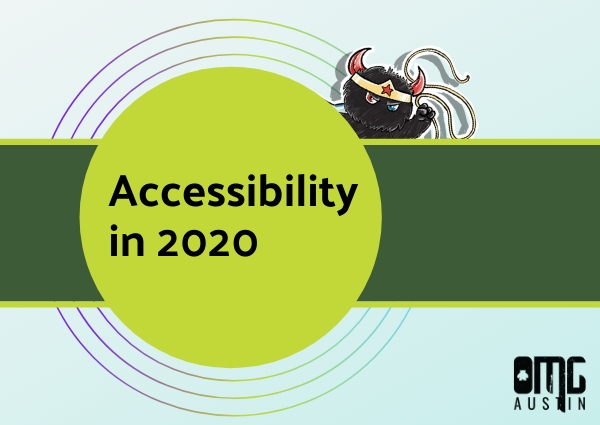Accessibility in 2020
 https://www.omahamediagroup.com/images/uploads/monster_gallery/Omaha-Media-Group-Black.jpg
https://www.omahamediagroup.com/images/uploads/monster_gallery/Omaha-Media-Group-Black.jpg

While the internet is a vast place of knowledge that provides an answer to whatever a search query is, that does not mean it is accessible to everyone. Yes, besides being friends with Google and other search engines, a website needs to be friends with those who have a range of disabilities.
The World Wide Web Consortium (W3C) also known as the WCAG (Web Content Accessibility Guidelines) have set regulations and standards in place to help companies and small businesses make sure their websites are accessible to everyone searching on the Internet, but why does it seem as if accessibility is just being spoken about? That is because it is. The American Disabilities Act (ADA) was signed in 1990 by George H.W. Bush which legally states that companies or businesses cannot discriminate against someone with a disability. One year later, Title II and Title III of this act were set into place. Title III is where most lawsuits arise from.
These regulations have been set for years and years, but as lawsuits happen and people speak up about these matters, companies are looking to quickly make sure their website accessibility standards are up to par.
So, what does a website need to be considered part of the website accessibility standards?
Content
Content is one of the most important things on a website, but for someone with a disability, this is even more critical. Content is king still to this day, and because of this, a website needs to make sure its content is optimized with the following checklist:
-
Capitalization
H1, H2 and H3
Lists or bulleted points
Audio descriptions on videos and multimedia
Simple is better
Alt tags
When someone with a visual impairment is searching the internet, oftentimes, this person is using technology that reads them the pages. This computer program is a wonderful piece of technology; however, it does only read what is on the website.
As a person with disabilities navigates the website, images are just as important as everything else. What is “IMG_098777(2).)? Alt tags are there to help describe the image in the best detail as possible to anyone who is on the website.
The Alt Tag can be as simple as (boy_reading_book.) Yup, that is it. For an infographic, you will want to create an alt tag or text that explains the entire infographic.
Error messages
Is that page 404’ing? First of all, yikes because all companies should have redirects on their websites, but for those who have issues navigating the Internet, this is a major headache. It might have taken a considerable amount of time to get here just to get an error.
WebFlow states that error messages should, “clearly describe the errors that are present and optionally include cues or instructions for resolving them.” Let this person know the new page or how to navigate to the newest page. Again, content is king.
Headings
A heading can be the most significant part of a website for those using screen readers or other technology to search the Internet. This is because those technologies oftentimes read the heading and skip over the content. A clear and easy to understand heading will be what the technology reads, so the next time you create headings, keep your friends in mind.
Larger and better CTAs
Those quick and grabbing CTAs that are all over the website are critical for accessibility. If the CTA is “click this link to hear or learn more” and the person has a visual impairment that makes it difficult to find said link, how do you think that will go? It is important that you tell consumers EXACTLY where to go even for those who are sighted with a disability. (Hint: even for everyday Joes, tell them where to go.)
We have all been to a website and have no idea where to go, even when the website tells us where to.
Contrast
In all of our research, contrast was the single most spoke about when it comes to website design and content marketing strategies for those with disabilities. W3G states that the color contrast needs to be 4.5 to 1. This is the background to and text. If the background is dark, the text has to be light enough to easily read.
Also, color alone will not help when it comes to differentiation main points and statements on a website because not everyone can see color. Instead, spend time creating and optimizing indicators that help those with disabilities to navigate through the site seamlessly. You still want enough contrast that someone with low vision or color blindness can tell exactly where that button is.
Typography
Not only is this part of website design 101, but a viewer comes to a website to read about a product/ service or a blog which is typography. What does a website need to have with their typography?
-
Font based in size relative units
Color and contrast
Font smoothing
Legible fonts
Paragraphs and spaces
Here is a perfect example of contrast and font sizes. The font size does meet the requirements and the font is clear and clean; however, the light gray on a white background makes it challenging for someone without disabilities to read this small paragraph. This is why a white on black would be better suited.
Over 26 percent of adults in the United States alone live and have some type of disability, which is one in four Americans. For those living with disabilities, it can be difficult to navigate and find technology that makes it accessible to search the Internet and their smartphones, and because of this, all websites NEED and HAVE to be checking off the website accessibility standards set in place.
A company’s building has to be accessible to everyone, so make sure your website is as well. Need help with this? Give us a call today for a free consultation on your website design and accessibility.
Posted In: Website Design, Website Development
